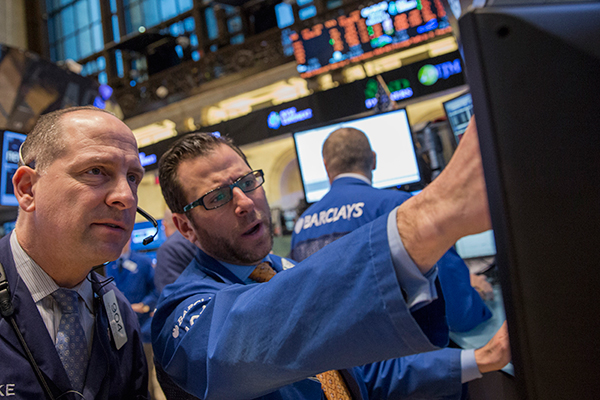Selling pressure looms as economic data may reveal weakness
By Li Xiang (China Daily) Updated: 2016-07-11 07:04
 |
|
Traders review data at the New York Stock Exchange. US stocks rose more than 1 percent on Friday in response to the largest monthly gain in employment in eight months, with the addition of 287,000 non-farm jobs in June. [Photo/Agencies] |
Selling pressure looms ahead of numbers that may reveal weakness
The Chinese stock market may be under selling pressure if the key economic data scheduled to be released this week reveals continued weakness of the Chinese economy.
The country is set to release a set of key economic data, including the GDP growth in the April-June quarter, industrial production, retail sales and fixed-asset investment for June and the first half of the year.
Economists said that China watchers may be disappointed this week as the economy is increasingly burdened by a substantial slowdown in fixed-asset investment, an important component of the country's GDP growth.
China's fixed-asset investment-it is a measure of capital spending on physical assets such as real estate infrastructure, machinery, land, installations and technology-has been expanding at the slowest pace since 2000.
The growth slowed from 19.9 percent in 2013 to just 9.8 percent last year, according to official data. The expansion further decelerated in the January-May period to just 9.6 percent year-on-year.
"Investment- and factor-driven growth has resulted in overcapacity, which is systemic, resulting from distorted resource allocations and maligned incentive structures in the economy. As a result, investment growth will continue to slow and investment as a share of GDP will continue to fall," said Jeremy Stevens, chief China economist at Standard Bank.
Gao Ting, head of China strategy at UBS Securities, said if data show economic activity continued to weaken in June, it could spark investor concerns and hurt market sentiment.
Last week, the benchmark Shanghai Composite Index surpassed 3,000 points for the first time in almost two months, as sentiment improved after Brexit-related fears eased and in anticipation of more government measures to prop up growth.
In the United States, payrolls data on Friday showed the largest gain in employment in eight months, with the addition of 287,000 non-farm jobs in June. In response, the benchmark S&P 500 Index for US equities jumped above 2,130.82 for the first time since May 21, 2015, before sliding back at the close to 2,129.90, still up 1.3 percent for the holiday-shortened stretch and capping two straight weeks of gains.
Gao at UBS Securities said that the official China's Purchasing Managers' Indexes for medium- and small-sized enterprises dipped to 49.1 and 47.4, respectively, highlighting the challenges facing them in production and operations. A level below 50 indicates contraction.
"That, coupled with broad-based slowdown in May property sales, new starts, investment growth and the slowdown of manufacturing investment, shows continued weakness in China's real economy demand and growth momentum," he said.
But Lukman Otunuga, research analyst at ForexTime Ltd, an online foreign exchange trader, found activity in the services sector a bright spot of the Chinese economy.
"Activity in China's services has surged to an 11-month high in June and this indicates Beijing is making good progress in fine-tuning the economy," he said.
Otunuga said expectations have mounted that the central bank may introduce fresh measures to spur economic growth.
"The Chinese stocks could be poised to trade higher if the renewed risk appetite from China growth optimism encourages investors to trade riskier assets," he said.
Analysts at French bank Societe Generale said that China's infrastructure spending remains another bright spot although the Chinese economy is moving from investment-led growth to consumption-led growth. The bank's asset management team has taken a long position on both onshore and offshore Chinese stocks exposed to the country's infrastructure spending and the national Belt and Road Initiative.
- How local spirits animate Disney
- For enterprising Kenyan, Beijing proves a strategic springboard
- Dalian Talent emerges as leading candle supplier
- Chinese know-how boosts Zimbabwe's farms
- Chinese homebuyers set sights on Brisbane
- Funding student housing in United Kingdom
- JPMorgan's Ulrich says she is well positioned to link East and West
- Where 'trend scouts' keep abreast of China's rise


















